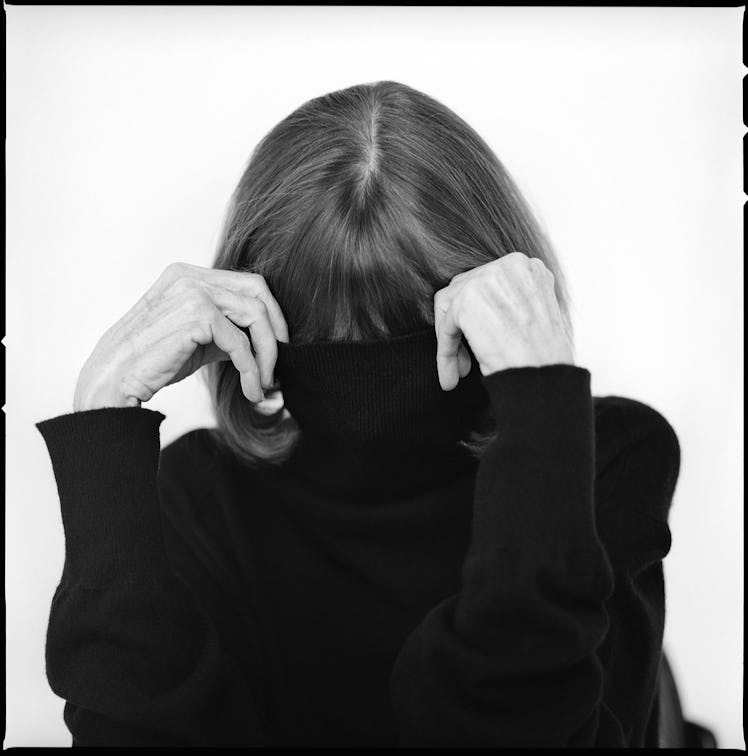
She was the very definition of “enigmatic,” the woman hiding behind insouciance and the occasional pair of Jackie O sunglasses, sage and inscrutable. But for all of her air of mystery, Joan Didion, who died in December 2021 at the age of 87, was first and foremost one of the great literary lions of our times. A pioneer of Tom Wolfe’s “new journalism” and a prolific, profound essayist and tragedian, through six decades of wry novels, nonfiction, and screenplays she plumbed the depths of the human condition with both mirth and despair. As with Fitzgerald and Cheever, her prose reflected a distinctly American sensibility, and more particularly, a California one.
She is the subject of a new museum retrospective, Joan Didion: What She Means, on display through January at UCLA’s Hammer Museum in Los Angeles. Described as an “exhibition as portrait,” the show, spread out over 10,000 square feet of toothpaste-white walls and hardwood floors and adroitly curated by New Yorker contributor Hilton Als, features a crafty mix of 215 exhibits ranging from the author’s personal possessions (the sign from her father’s real estate brokerage, her great-grandmother’s shawl) to works of sculpture, painting, photography (and, oddly, a looping film clip of a close-up of John Wayne) presented to contextualize her life and work.
Cover of Vogue, August 1956 issue, featuring the model Margo Moore. Magazine loose issue: ink on paper. 12 7/8 × 9 3/4 × 1/4 in. (32.7 × 24.8 × 0.6 cm). Condé Nast Archive. Photo: Richard Rutledge, Vogue © Condé Nast
Announcement of the twenty-first Prix de Paris in the August 1956 issue of Vogue. Condé Nast Archive
Born in Sacramento, Didion was a bookish girl who spent her adolescence typing out Ernest Hemingway’s novels to absorb their unique sentence structure. She went on to become a writer at Vogue, foreshadowing the unlikely fashion icon she would become. (Later in life, she was featured in campaigns for the Gap and Céline.) She married fellow writer John Gregory Dunne, and the pair was quickly woven into the fabric of midcentury New York literary society. His death in 2003 prompted her most famous memoir, The Year of Magical Thinking, which won the National Book Award in 2005.
Museum retrospectives that celebrate the lives of movie stars or fashion designers promise delicious window shopping of awards, clothes, speeches, sketches. Dissecting an author in a wide open space is a far more onerous task. It is to Als’s credit that the show’s relentless focus remains dexterously steadfast on Didion’s arch, droll written work, which is liberally sprinkled throughout the space like seasoning on a particularly sumptuous meal. In an excerpt from 1967’s “Goodbye to All That,” she reflects on her recent move from New York to Los Angeles: “Many of the people we knew in New York think this is a curious aberration, and in fact tell us so,” she muses. “There is no possible, no adequate answer to that, and so we give certain stock answers, the answers everyone gives. I talk about how difficult it would be for us to ‘afford’ to live in New York right now … All I mean is that I was very young in New York, and that at some point the golden rhythm was broken, and I am not that young anymore.” As the New York Times columnist Frank Bruni once sagaciously put it, “Syntax and sensibility. Nobody wed them quite like Joan Didion.”
Helen Lundeberg, Studio-Afternoon, 1958-59. Oil on canvas. 24 × 30 in. (61 × 76.2 cm). Long Beach Museum of Art, Gift of Joseph H. Miles, 1972 © The Feitelson / Lundeberg Art Foundation. Photo: Gerard Vuilleumier
A quote recalling her lack of sophistication arriving in Manhattan is presented next to German painter Silke Otto-Knapp’s Figure by Window, depicting the expectant form of a young woman; juxtaposed photographs of drag queens and the Daughters of the American Revolution in 1961 supplement a telling quote from 1989’s “Some Women” about the hypocrisy of glossy magazine portraits where subjects were told to “just be themselves”: “What occurred … was a transaction of an entirely opposite kind: success was understood to depend on the extent to which the subject conspired, tacitly, to be not ‘herself’ but whoever and whatever the photographer wanted to see in the lens.” In this manner the curation transcends the merely clever, breaking through the surface with messaging that is artful, thoughtful, and most of all, meaningful.
Presented in chronological order, the show proves a very satisfying carousel spin through an exceptional life. Als, who has previously curated shows on James Baldwin and Toni Morrison, says he hopes it will both demythologize Didion, whose dour countenance and exacting nature contributed to the persistent image of her as the Morticia Addams of letters, while also rounding out her legacy as a literary icon. Previous Didion retrospectives, he says, “stop when it comes to the personal essays, and they don’t see that from about 1979 on that she was writing about politics, what she called ‘political fiction,’” he says. “She had a kind of relationship to the world stage that was much broader than she was given credit for.”
Didion put it best herself, in her 1979 essay collection The White Album. “We tell ourselves stories,” she wrote, “in order to live.”